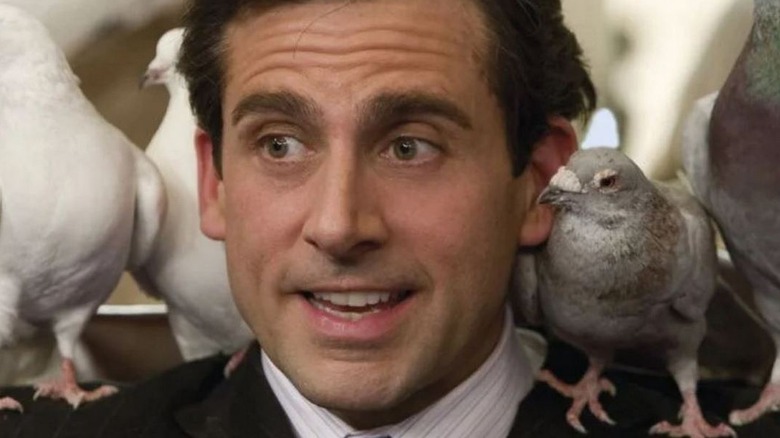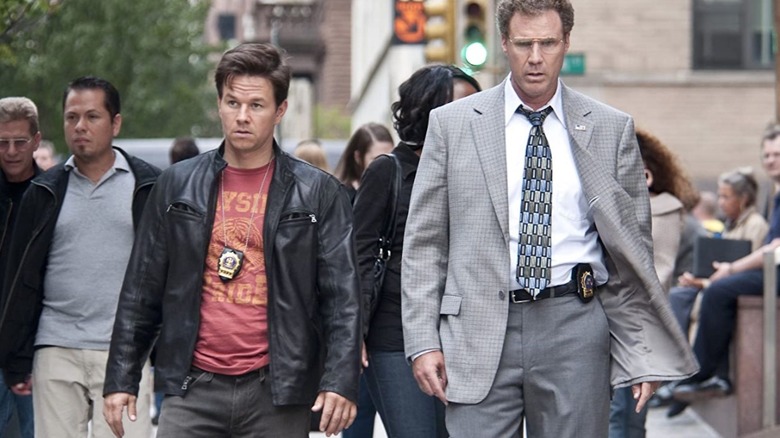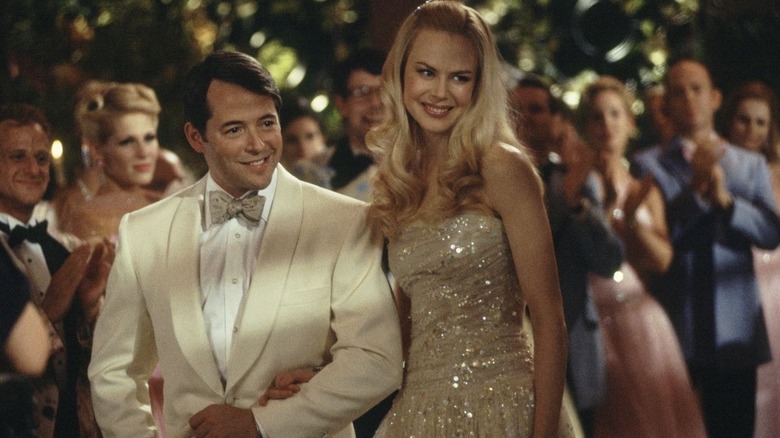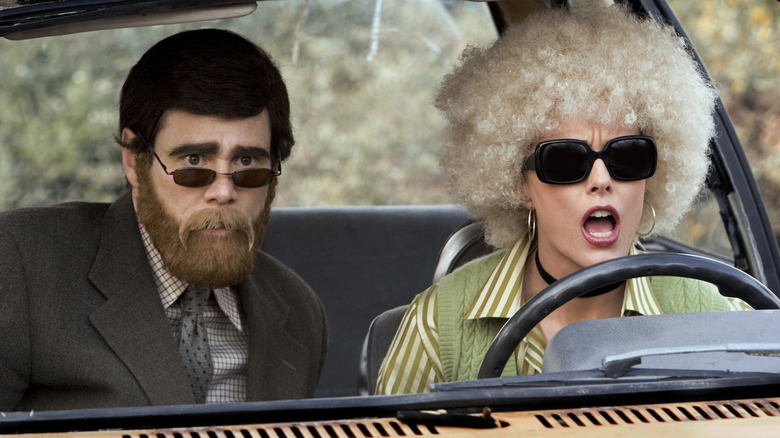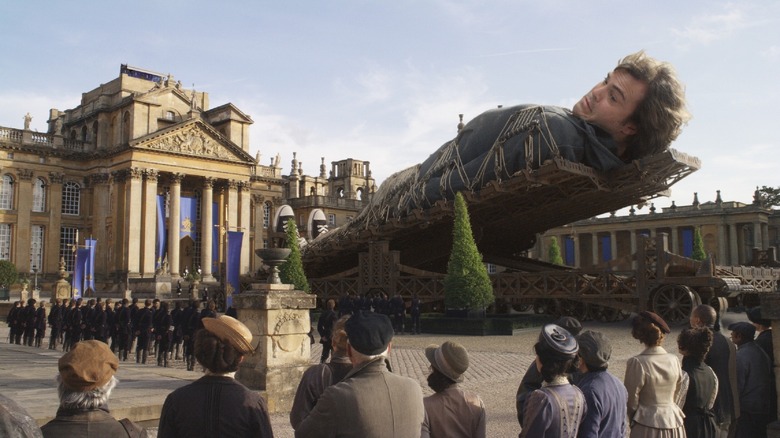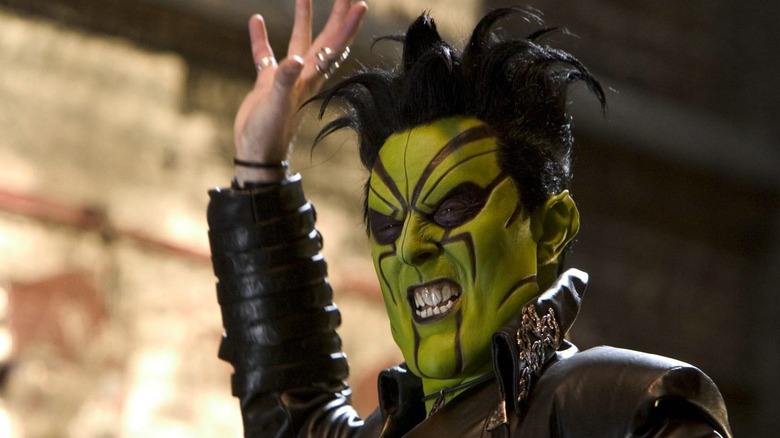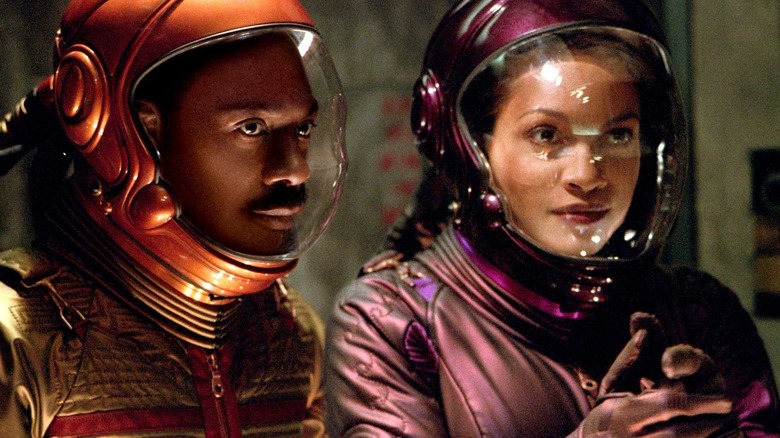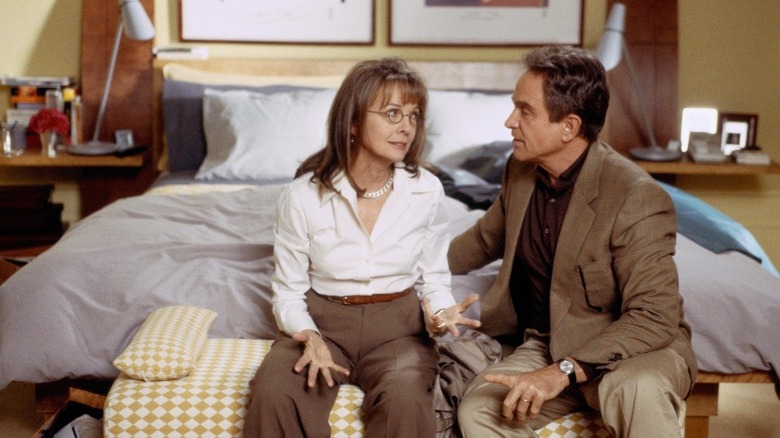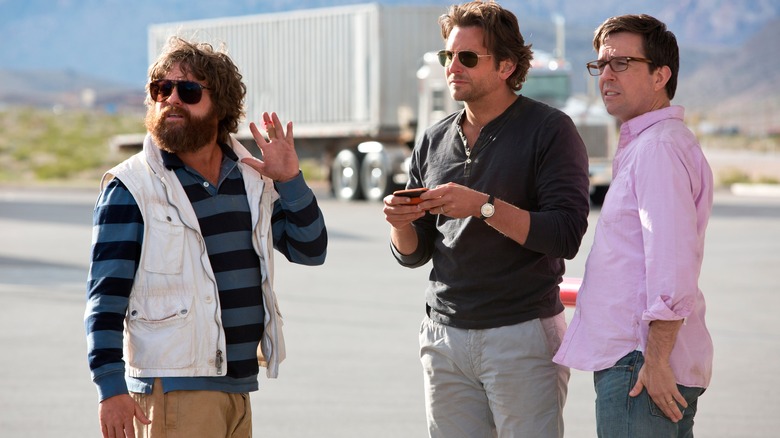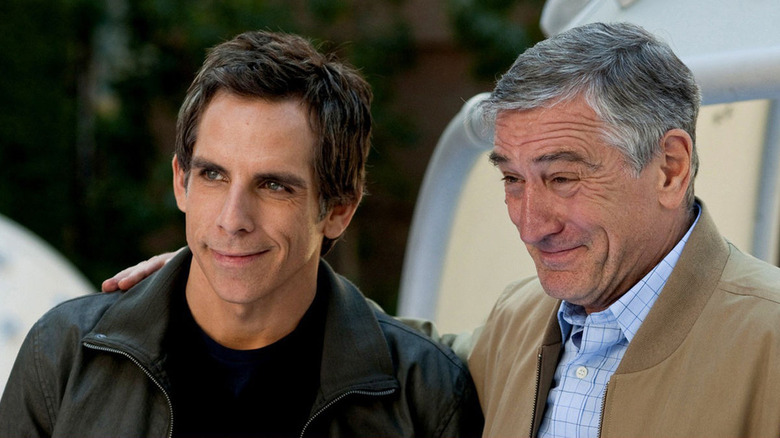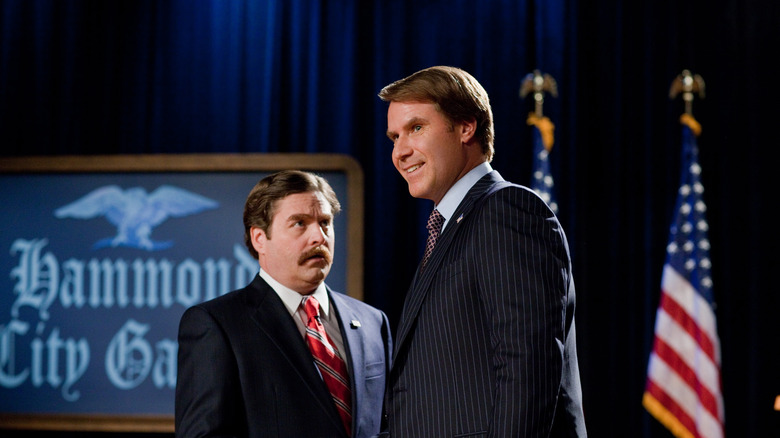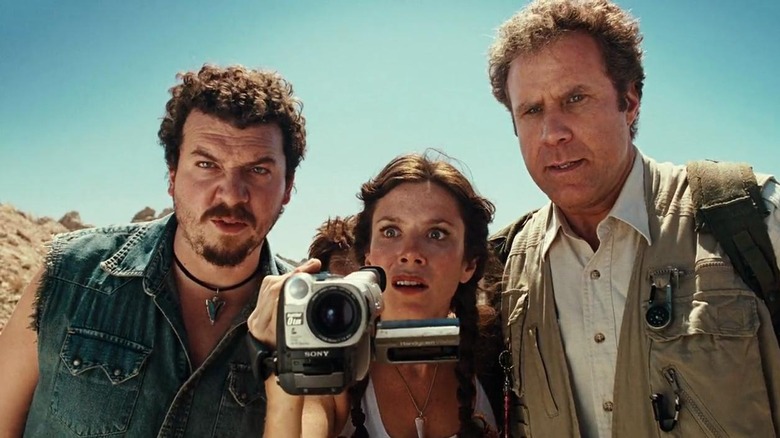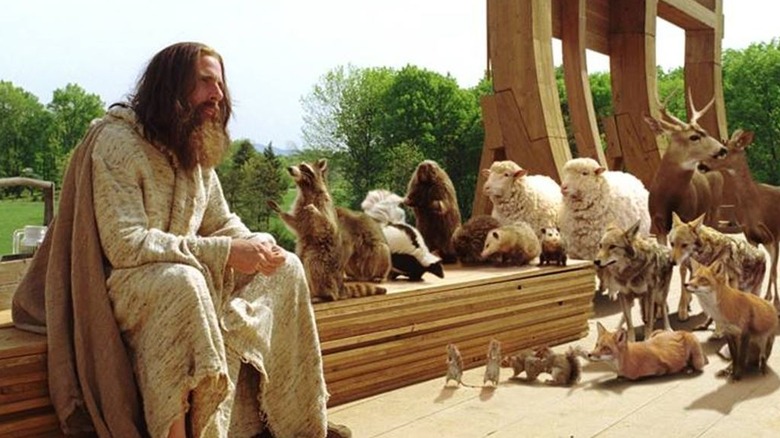Comedy Movies That Cost More Than You Think
When you think of movie genres that aren't cheap to make, your mind likely darts automatically to animated movies, action thrillers and superhero films. While it's true that those are costly endeavors, another genre that tends to rack up sizeable budgets is big-screen comedies. Despite rarely featuring pricey sights like CGI robots or cities exploding, comedies can still be expensive thanks to a whole slew of factors, including the paychecks needed to get big-name actors to headline your movie. Over the years, plenty of comedies have scored large budgets, but some have ended up with particularly immense price tags. Among those are a pair of sequels to Jim Carrey comedies (both of which ditched Carrey), an infamous Eddie Murphy debacle, and a comedy headlined by one of the most famous actors of the 20th century.
The road to such elaborate budgets varies greatly based on the comedy. Some were always meant to be costly affairs, others saw their budgets spiral out of control due to production problems. Whatever the reason, these comedies ended up costing way more than you might imagine. In the process, they demonstrate that summer blockbusters aren't the only movies that can end up being staggeringly expensive.
The Other Guys
The first Will Ferrell/Mark Wahlberg collaboration, "The Other Guys," is today remembered for gags like Michael Keaton's character inadvertently making references to TLC songs. However, another notable quality of the feature was its budget. This comedy ended up costing $100 million to produce, a noticeable step up from the budget of previous Will Ferrell comedies directed by Adam McKay, like the $72.5 million budgeted "Talladega Nights: The Ballad of Ricky Bobby" or the $65 million price tag of "Step Brothers."
Unlike those, however, "The Other Guys" had action sequences and lots of them. Part of the joke of the movie was watching two bumbling cops who are out of their league navigate shootouts lifted from a vintage action movie, as established in an opening set piece centered on two legendary cops meant to emulate the kind of chase scenes seen in a Michael Bay movie. That approach does not come cheaply. Also proving costly? Shooting in New York City. While many movies go to locales in Georgia or Canada to double for the Big Apple, "The Other Guys" actually was filmed in New York City. Then there's the presumably hefty paydays for Ferrell and Wahlberg. Considering all of these individual elements, it becomes easy to see why this particular comedy turned into such a pricey endeavor, even compared to other star vehicles from the actor in the same era.
The Stepford Wives
In May 2003, New York magazine reported that the 2004 remake of "The Stepford Wives" was in more than a bit of trouble. Aside from divulging that the film's initial principal photography went two months over schedule, the outlet also reported that a new round of reshoots was ordered following test screenings. The piece also mentioned that there were difficulties in securing the busy Nicole Kidman for the reshoots, not likely to be a cheap prospect.
Considering all of that, it becomes clearer how "The Stepford Wives" wound up with a $100 million budget. The production was always slated to be a costly one, with The New York Times reporting that the project had an initial budget of $90 million. The box office allure of Nicole Kidman as well as the movie being a remake of an old well-known thriller gave Paramount Pictures confidence that "The Stepford Wives" could always be profitable even with a hefty price tag. Unfortunately for its financers, this iteration of "The Stepford Wives" couldn't even clear $100 million worldwide, making that troubled production a lot of fuss for nothing.
Fun with Dick and Jane
By 2005, Jim Carrey had been a reliable comedic leading man for a little over a decade. That level of box office reliability meant his star vehicles could afford to be a little more pricey than typical comedy features. With his 2005 motion picture "Fun with Dick and Jane," Carrey put that theory to the test by headlining a movie that cost $140 million to produce. For comparison's sake, this was a heftier budget than projects like "Master and Commander: The Far Side of the World" and "Ant-Man and the Wasp."
Part of the budgetary problems on "Dick and Jane" came from its tumultuous production. The biggest hiccups included original director Barry Sonnenfeld departing the film weeks before it was originally set to start rolling while initial leading lady Cameron Diaz dropped out of the project just before its second principal photography start date. The production became so plagued with issues (including extensive reshoots designed to adjust the movie's tone) that a piece on "Fun with Dick and Jane" for The Los Angeles Times featured a baffled Carrey himself wondering aloud how the movie's price tag had gotten so out of hand. Carrey was a box office powerhouse circa 2005, but even his financial success wasn't enough to justify the outrageous budget of "Fun with Dick and Jane."
Gulliver's Travels
Save for Peter Jackson's "King Kong," Jack Black has never headlined a live-action movie that cost over $100 million to make. Well, almost never. The one exception to this came from the 2010 film "Gulliver's Travels." This feature used a $112 million budget to try and replicate the success of fellow 20th Century Fox family movie "Night at the Museum" from four years prior. Specifically, "Gulliver's Travels," like "Museum," plopped a famous comedian into a family-friendly setting surrounded by CGI co-stars — one that would, hopefully, become a massive Christmastime hit.
Given that "Night at the Museum" cost $110 million to make, it's not inconceivable why "Gulliver's Travels" had a $112 million budget. However, the difference there was that Ben Stiller had already headlined multiple movies (like "Meet the Fockers" and "There's Something About Mary") that would have been profitable even with $100+ million budgets. Black, meanwhile, didn't quite have that box office track record. Using a $112 million budget on "Gulliver's Travels" to realize things like a duel between Black and a gigantic CGI robot just wasn't a wise financial decision, as seen by the film's eventual $232 million worldwide haul. Trying to make the next "Night at the Museum" only resulted in "Gulliver's Travels" becoming the next overly expensive comedy that failed to make a dent at the box office.
Son of the Mask
"The Mask" isn't a comedy you can make without visual effects. Then-revolutionary CG effects were required to ensure that Jim Carrey could engage in all kinds of zany activity that was previously only possible in hand-drawn cartoons by maestros like Tex Avery. Despite the prominence of CGI, "The Mask" wasn't a bank-breaking project in terms of budget, costing just $18 million. Such financial discretion was not around for its sequel, "Son of the Mask," which ditched Carrey but amped up the budget to $100 million.
One reason for the vastly more expensive budget was how the powers of the Mask manifested in this movie. Whereas in the original movie Carrey's character only sometimes had the powers of the Mask, "Son of the Mask" concerned a baby who was born with its supernatural abilities. Thus this newborn was always stretching, dangling off the ceiling, or doing any other number of zany actions that could only be accomplished through expensive CG work. The extensive amount of development time for the project (which resulted in an 11-year gap between "Mask" installments) further ensured that "Son of the Mask" ran far away from its predecessor's more frugal nature.
The Adventures of Pluto Nash
Science fiction movies don't come cheap. After all, it takes a lot of money to realize elaborate spaceships or otherworldly aliens. So it was with the Eddie Murphy sci-fi comedy "The Adventures of Pluto Nash," which cost $100 million to make, a price that could be attributed to the inherently expensive nature of this genre as well as Murphy's requisite paycheck. Of course, "Pluto Nash" ended up becoming one of the most notorious bombs in history, so it's no surprise to learn it did not make back its $100 million budget.
In an interview with SlashFilm, "Pluto Nash" director Ron Underwood went into detail about the 2002 film's troubled production, including a lengthy principal photography process that doubtlessly contributed heavily to the large budget. This interview also mentions how early negative internet reactions to test screenings of "Pluto Nash" led to Universal and Castle Rock Entertainment ordering costly reshoots that lasted for two weeks. A review of "Pluto Nash" for the Orlando Sentinel, meanwhile, observed how the cost of the production was further increased by an extended 22-year development process. Before cameras ever started rolling, "Pluto Nash" had spent two decades getting fine-tuned as a screenplay, a process that did not come cheap nor yield successful results.
Sci-fi movies are usually expensive, sure, but "The Adventures of Pluto Nash" had a clearly troubled production that helped cement it as one of the priciest comedies to ever exist.
Town and Country
When Warren Beatty appeared in his first theatrical release in 15 years, the 2016 feature "Rules Don't Apply," it caused some to wonder where he'd been for so long. Why had a silver screen legend like Beatty taken so much time away from headlining movies? Well, starring in an all-time box office dud like "Town and Country," Beatty's last star vehicle before his extended hiatus, certainly couldn't have helped. This comedy cost $105 million to produce, but despite featuring many famous faces in addition to Beatty, it only grossed $10.4 million globally.
The saga of "Town and Country" and its troubled production has become the stuff of Hollywood legend. In a breakdown of the film's messy trip to the silver screen, NME noted that the film's budget ballooned thanks to its shoot taking significantly longer than expected. During that time, costly issues — like script rewrites and reshooting footage that had been stolen — kept driving the costs further and further up. Thanks to a principal photography stint that lasted a whopping two years, "Town and Country" cost immensely more than its original budget. Once it was finally finished, there was just no way, no matter how many recognizable mugs were on the poster, that it could attract enough moviegoers to make a profit. No wonder Beatty needed a break from moviemaking after this exorbitant debacle.
The Hangover: Part III
The very first "Hangover" movie cost just $35 million to produce. When it came time for a sequel, things would be much more expensive, with the affair costing $80 million. When "The Hangover: Part II" also proved successful, it was only a matter of time before a third installment was unleashed on the public. The question now, though, was where the budget would end up. Turns out, "The Hangover: Part III" would further ratchet up the costs by running up a massive $103 million budget.
Where did all that money go? Primarily to the franchise's three leading men. Bradley Cooper, Ed Helms, and Zach Galifianakis all wanted to be properly compensated for another "Hangover" adventure. Eventually, they each scored a $15 million payday for reprising their respective roles. On top of that, Ken Jeong snagged a $5 million salary for playing Leslie Chow again, meaning roughly half the film's budget went towards four actors. The cash needed to get all these actors onboard exceeded the entire budget of the original "Hangover." Once those paychecks were taken care of, money still needed to be spent on the rest of "The Hangover: Part III," which included shooting in lavish locales like Las Vegas. That's how "The Hangover: Part III" ended up costing just over $100 million to produce.
Little Fockers
"Meet the Fockers" wasn't just a hit, it was a monster success, grossing nearly $280 million at the domestic box office. With the film being one of the biggest live-action comedies ever, it was apparent Universal Pictures/DreamWorks Pictures would be angling to get another sequel off the ground. To do that, though, would be a pricey venture, with the eventual follow-up, "Little Fockers," costing $100 million to make. That wasn't just the kind of budget usually associated with action-packed blockbusters — it was also nearly double the $55 million price tag of the original film in this series, "Meet the Parents," plus a substantial increase over the $60 million budget of "Meet the Fockers."
Many comedies score $100+ million budgets thanks to tumultuous productions that gradually run up the costs. In the case of "Little Fockers," with it being a sequel and carrying a star-studded (and expensive) cast, the financiers involved always knew it'd be a costly venture. In fact, Deadline reported in August 2010 — as a series of reshoots were underway for "Little Fockers" — that the project came in under budget during its principal photography. Even with that feat, though, "Little Fockers" still proved to be a significant investment financially and a sign of how costly individual installments in a comedy franchise can be as the years go on. However, with a $300+ million worldwide haul, it appears to have been the rare costly comedy that actually made its money back.
The Campaign
Around 2012, the basic premise of "The Campaign" probably sounded like dynamite to studio executives: Pair up funnyman Will Ferrell with "The Hangover" star Zach Galifianakis in a political-themed comedy released during a Presidential election year. It seemed like a can't miss proposition. The one problem the project faced, though, was that "The Campaign" cost $95 million to make. Despite being an original project, it only cost slightly less than Galifanakis's later comedy vehicle "The Hangover: Part III," which was part of a massive franchise.
It's a bit difficult to tell what specific parts of "The Campaign" brought the budget up so high, especially since the salaries of its leading men have never been officially disclosed. However, a visit to the film's set by Collider divulged that the film did make use of elaborate sets, such as an intricately detailed two story house built on a soundstage. That's certainly the kind of element that can help drive up a film's budget. Whatever caused the budget to escalate, "The Campaign" wasn't as lucrative as Warner Bros. executives likely imagined it could be, as it grossed just $104.9 million globally (including a disastrous $18 million overseas). Sometimes, even the most promising movies don't pan out, especially when they cost as much as "The Campaign."
Land of the Lost
"Land of the Lost" was a reasonably popular TV show back in the day, but it's not something that's endured to the point of being a universally beloved icon. Therefore, one would assume any modern movie adaptation of the property would be priced accordingly so that it wouldn't have to attract a massive audience to be profitable. But the 2009 motion picture "Land of the Lost" opted to go the opposite route with a $100 million budget, a sum it never came close to recouping with a worldwide gross of just $69.5 million.
The sizeable cost of "Land of the Lost" came down to the fact that this wasn't just a typical Will Ferrell comedy, but a Will Ferrell comedy that took place in a fantasy world. With a CGI T-Rex nemesis and lots of Sleestaks to realize, "Land of the Lost" was a visual effects-heavy project. Plus, casting Ferrell in your movie is never a cheap option. Despite all the visual effects razzle-dazzle, "Land of the Lost," thanks to competition on opening weekend from "The Hangover," failed to connect with audiences. Perhaps this is one TV adaptation that should have just left its source material alone.
Evan Almighty
Once "Bruce Almighty" became the biggest box office smash of Jim Carrey's career, it was inevitable there would be a sequel. However, nobody could have imagined that the follow-up would be as expensive as "Evan Almighty." A comedic take on the Noah's Ark story with Steve Carell at the center, the project was always going to be a costly affair thanks to all the visual effects necessary to execute any story involving a massive boat and an equally enormous flood.
"Evan Almighty" started principal photography with a sizeable $140 million budget. But that cost escalated to $170 million as the production proceeded thanks to, among other issues, the challenges of filming live animals on a movie set as well as executing big set pieces like a gigantic ark making its way through a flooded Washington D.C. Universal Pictures tried to throw cold water on all the bad buzz by telling outlets like Variety that such a budget was reasonable for a film like "Evan Almighty," which was designed to be a blockbuster. However, it was hard to imagine a sequel deprived of Jim Carrey could manage that. In the end, "Evan Almighty" only grossed $174.3 million globally, a meager sum considering this project ended up being the costliest comedy in history.
